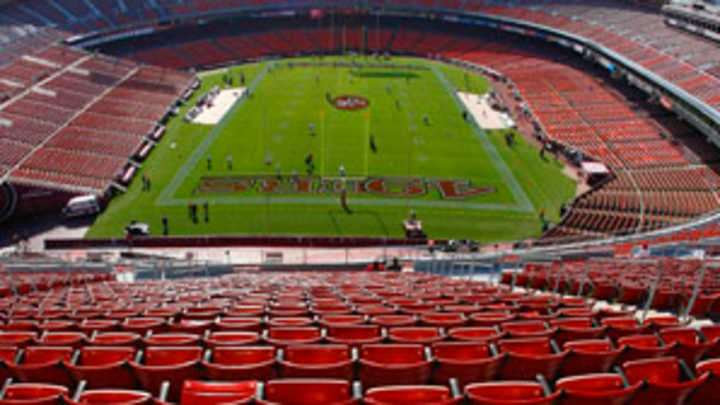Built on a dump, Candlestick Park gave sports world so much


Of all the beautiful names given to the places we play games -- Colosseum and Craven Cottage and Camp Nou; Molineux and Maracaña and Madison Square Garden; Polo Grounds and Elysian Fields and Fabulous Forum -- none was ever more evocative than Candlestick Park, which called to my adolescent mind an innocent nursery rhyme ("The butcher, the baker, the candlestick maker") and an implement of murder ("Professor Plumb, with the candlestick, in the conservatory").
My first sight of it, as a 10-year-old riding in the way back of a rented station wagon up the 101 from SFO, confirmed this strange dichotomy. Before the Golden Gate Bridge or Fisherman's Wharf or a single cable car appeared, suddenly there was Candlestick Park, ominously isolated on a windswept promontory. It was a revelation, as if Willie Mays had all along been playing centerfield on Alcatraz Island.
It's always been like that, of course, part Say-Hey, part Mayday: In the park's second season, the 1961 All-Star Game saw Stu Miller blown off balance and into a balk; the idyll of the 1989 World Series was shattered by the horror of the earthquake; the Niners-Steelers Monday night game last December twice went dark, as if the police had been called to shut down a party and simply pulled the plug. Which, in a manner of speaking, is what is happening to Candlestick. The flame is flickering and will soon go out forever, and unless Niners' helmets are replaced by miner's helmets, that will be the end of it.
Happily, as a possible last hurrah, Candlestick on Sunday restores some order to the universe by hosting the NFC Championship Game for a record eighth time, but only the first time in 14 years, while the AFC championship is hosted -- more or less -- by Tom Brady, who grew up in San Mateo, was a 4-year-old at The Stick for The Catch in '82, attended the same high school as Barry Bonds, and is almost as much of Candlestick's quarterback legacy as Joe Montana and Steve Young.
One hesitates to romanticize a dump like this, and Candlestick was famously built on landfill, and this particular dump was only ever meant to be endured, not enjoyed. It had an inauspicious birth: In 1960, the first pitch of the first Giants' game there was thrown out by Richard Nixon. And it had an even less auspicious pregnancy: "Not too far away is the point of destination for the city's vast sewage system," raved UPI, before the park ever opened. "Even on crisp, cool days there is a far from pleasing aroma."
Of course, those "crisp, cool days" were a welcome respite from the Arctic August nights, when the wind blew the hot dog wrappers up against the chain-link outfield fence, and baseball fans wore parkas beneath blankets, prompting the Giants in 1984 to award medals -- the Croix de Candlestick -- to any fan who stayed until the final out of an extra inning game. The pins were embossed Vini, Vidi, Vixi: "I Came, I Saw, I Survived."
It is a measure of how decrepit Kezar Stadium was that the Niners, immediately after hosting the first NFC Championship Game there, in 1971, abandoned their ancient home field to the seagulls and whatever hippies were left next door in Haight-Ashbury and moved into The Stick. It became the (metaphorical) hothouse in which the West Coast Offense blossomed, and that offense will be the Stick's parting gift to the world.
Prior to the rise of Bill Walsh and Joe Montana and Jerry Rice -- and speaking of parting gifts -- San Francisco principally meant three things to me growing up in a certain time and place: Rice-a-Roni, "the San Francisco treat," perennial parting-gift for game-show losers of the '70s and '80s; Karl Malden and Michael Douglas in The Streets of San Francisco, the Quinn Martin Production with the most funkadelic theme music on TV; and Candlestick Park, whose mystique I learned later owed entirely to its name. As an adult, there was nothing so dispiriting as driving into San Francisco to see "3Com Park" or "Monster Park" defacing the freeway signs.
I only ever covered baseball at Candlestick, which is a bit like only ever covering "Disney On Ice" at the Montreal Forum, but that ball diamond has its own legacy, and not just in Mays, McCovey, Marichal, Clark and Bonds. In shallow centerfield, just beyond second base, where bloopers fell for cheap singles, the Beatles took the stage for their final concert on a frigid August night in 1966, walking off forever after playing Long Tall Sally.
And now the Niners, with one foot out the door for Santa Clara, stage one more blowout on the big stage, the conference championship at Candlestick, which deserves a Croix de Candlestick of its own. Vini, vidi, vixi. It came, it saw, it survived. And now, or soon -- Stick transit gloria mundi -- it passes into history. If any place knows about passing, this is it.
